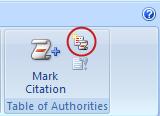
The feature or some of the options described in this Help topic are only available if support for English (U.S.), Canadian French, or Dutch is enabled through Microsoft Office Language Settings.
What do you want to do?
A table of authorities lists the references in a legal document, along with the numbers of the pages the references appear on. To create a table of authorities, you mark citations and Microsoft Word inserts a special TA (Table of Authorities Entry) field in your document. You can then search the document for the next long or short citation to mark, or you can automatically mark each subsequent occurrence of the citation. If you don’t want to use the existing categories of citations, such as cases or statutes, you can change or add categories of citations.
When you build a table of authorities, Word searches for the marked citations, organizes them by category, references their page numbers, and displays the table of authorities in the document. For example, the field
creates the following entry in the "Cases" category of a table of authorities:
Baldwin v. Alberti, 58 Wn. 2d 243 (1961) 5,6
Note: You can also click the References tab and then click Mark Citation in the Table of Authorities group.
Note: If you want to format the text, right-click the text in the Selected text box, and click Font. Select the formatting options that you want to use.

in the Paragraph group on the Home tab. On the References tab, in the Table of Authorities group, click Insert Table of Authorities.
Tip: To use additional options for customizing a table of authorities, you can use fields. For example, you can build the table of authorities for only part of the document.
To change a table of authorities entry, you need to modify the text in the table of authorities entry field.
If you don’t want to use the existing categories of citations, such as cases or statutes, you can add or change categories of citations.